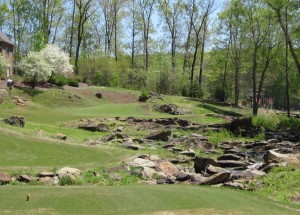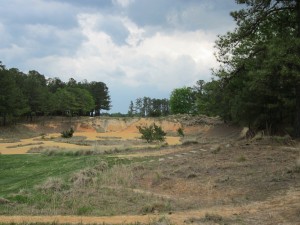Pinehurst beckons for avid golfers
July 18, 2014
This spring’s annual golf trip with the Conlon brothers and the rest of the usual crew took us back to Pinehurst, North Carolina, as the Sandhills region prepared for this year’s highly successful double U.S. Opens.
Our first day’s round took place in bright weather at Longleaf. The Midland Road course is visually famous for the rails and other reminders of the acreage’s prior existence as a horse track (800-542-0450).
Most players won’t actually see those rails up close and personal, but some of us did.
The front side is relatively open, and the back nine’s tree-lined fairways require players to tighten up their accuracy.
This is a good first day course, whose greens hopefully continued to recover from the hard winter.
Our second round required a long ride out Interstate 73 to reach Tot Hill Farm. This Mike Strantz design is rated by Golf Digest magazine as one of the toughest golf courses in America by Golf Digest (800-868-4455).

This par-3 hole at Tot Hill Farm sits on a hillside ledge just above a rocky stream. And no, it is not an easy par-3, especially from the rocks in the stream.
They weren’t kidding.
Unlike Cape Region courses, Tot Hill features huge elevation changes on a remarkably hilly, rocky layout. Golf carts are a must, not least of which because of the occasional long runs between greens and tees. A walking round on this course would provide a stern test of physical fitness.
There’s no doubt that Tot Hill is a beautiful place. Chip Newton also said this was the first course he’d ever played where the designer routed the layout using a creek, and he was not completely exaggerating. The creek is actually a factor on thirteen holes.
There’s also no doubt that this is a target-style golf course on steroids, where any wayward shot can lead to a quick double-bogey or worse. Among our group, Ray Theim was the only one to play to his handicap, thanks to his remarkably steady golfing skills.
Our third round returned the group to one of our favorites, the Legacy Golf Links, only a few minutes ride south of Southern Pines/Pinehurst in the nearby town of Aberdeen, North Carolina (800-344-8825). This Jack Nicklaus II design has held up well since its 1991 opening, and the current owners recently rebuilt the greens.
The course is a nicely challenging mix of open and treed fairways, with water challenges frequently adding to the assessment of the wind’s effects. Of all of the courses we played this year, Legacy had the nicest, smoothest greens.
We had another travel day for our fourth round, this time back to Tobacco Road, another Strantz design we’d played before (877-284-3762). Our group played a shamble format. All players played their own ball, after first bringing their tee shots to the spot where the best drive of each foursome landed.

The view from the tee box at one of the holes at Tobacco Road. The fairway is just over that sandstone cliff in the background.
That format removes much of the frustration that might otherwise mar the enjoyment of the occasionally startling holes. On the other hand, a good drive won’t mean much if the next shot lands in one of the deep greenside bunkers, 15 feet or so below the greens.
Nonetheless, a good shot on a visually stunning course like Tobacco Road is truly memorable, such as Kevin Conlon’s 180-yard 4-iron to seven feet on the 383-yard seventh hole.
Our final getaway round involved driving east and a little bit north to Anderson Creek Club, a Davis Love III design (910-814-2115).
The Delaware connection is obvious with the first few steps into the clubhouse.
David Levinson, the former Delaware State Insurance Commissioner and U.S. Senate candidate, is the developer of the 2700-acre development. The clubhouse walls feature several photographs and framed letters about Levinson and the project, including a prior visit to the site by Vice-President Joseph Biden.
Our gang liked the course, in part because most of the challenges were clearly presented to golfers as they stood on the tees. On a few occasions, prior experience or local knowledge would have helped.
Love also presented several opportunities for golfers to use the terrain to boost their scoring chances, such as with downhill doglegs that rewarded a draw that matched the design.
I can easily see us coming back to Anderson Creek the next time.

